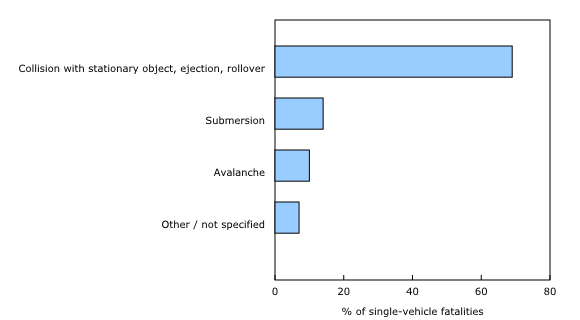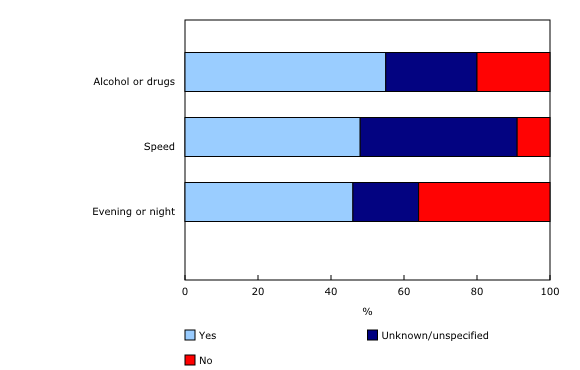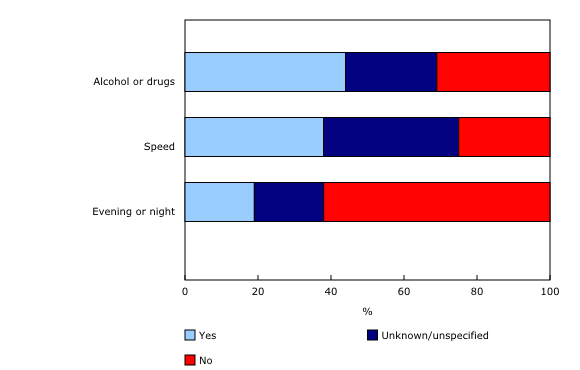Circumstances surrounding snowmobile fatalities in Canada, 2013 to 2019
Archived Content
Information identified as archived is provided for reference, research or recordkeeping purposes. It is not subject to the Government of Canada Web Standards and has not been altered or updated since it was archived. Please "contact us" to request a format other than those available.
Released: 2021-01-22
Snowmobiles are used across Canada for recreation, transportation and work. Although snowmobiling is a popular form of activity, there is still potential for injury and death. From 2013 to 2019, on average, 73 people in Canada died from unintentional snowmobile events every year, across all provinces and territories. These results are based on new insights released today from the Canadian Vital Statistics – Death Database (CVSD) and the Canadian Coroner and Medical Examiner Database (CCMED).
Understanding the circumstances surrounding snowmobile fatalities is the starting point for implementing preventative measures. Although the circumstances are not always known, important insights can be gained from looking at what has been reported on the decedent. Recommendations to minimize risk while snowmobiling include not riding while impaired from alcohol, travelling at safe speed, wearing a helmet, wearing clothes appropriate to the weather, carrying safety equipment appropriate to the environment, travelling in a group, and avoiding snowmobiling on ice or where there is a risk of avalanche.
Nine in ten snowmobile fatalities occur among men
The vast majority of snowmobile fatalities occur among men (89%). Even when we take into account the higher rate of males participating in off-road vehicle recreation, the rate of death among males (2 deaths per 100,000 males who ride snowmobiles, all-terrain vehicles [ATVs], or other off-road vehicles) is five times higher than among females (0.4 deaths per 100,000 female riders).
Snowmobile fatalities occur among all age groups, although three in four fatal events involve adults aged 25 to 64. This is consistent with the proportion of riders of snowmobiles, ATVs and other off-road vehicles in this age group.
Three-quarters of fatalities involve a solo snowmobile rider
In three-quarters of fatalities, the driver was alone on the snowmobile, while in 16% of cases, they were riding with at least one other person (9% unspecified). When the snowmobile driver was riding with at least one other passenger at the time of the event, the drivers accounted for 45% of fatalities and passengers 25% (in 30% of the deaths the information on position was not specified).
Among youth aged under 16, in one-third of fatalities, they were driving the snowmobile without any passenger. Among fatalities when another person was on the snowmobile, the youth was always reported as the passenger or being towed. In 33% of deaths among youth, the information on position was not specified.
Eight in ten snowmobile fatalities involve single-vehicle events
Of snowmobile fatalities, 80% were single-vehicle events while the other 20% involved a collision with another snowmobile or vehicle. In 69% of fatal multi-vehicle collisions, the snowmobile collided with a car or truck. This often occurred at an intersection between a public road and snowmobile trail. In 31% of multi-vehicle collisions, the snowmobile collided with another snowmobile. These collisions occurred primarily on a trail.
Of the single vehicle events, 7 in 10 involved a collision with a stationary object, an ejection or a rollover, followed by submersion- (14%) and avalanche-related (10%) fatalities. These events occurred in a number of locations, including trails, mountains, lakes, rivers, or other bodies of water, and roads or intersections.
Understanding the risk factors involved in these events provides important insights for implementing preventative measures.
Risk factors are reported in more than half of collisions with a stationary object, ejections and rollovers
As described by the Canadian Council of Snowmobile Associations and a snowmobile-related trauma article from the Canadian Journal of Surgery, risk factors—including alcohol or drug consumption, riding at high speeds and impaired visibility—may affect a driver's ability to safely manoeuvre a snowmobile. From 2013 to 2019, alcohol or drug use (55%), excessive speed (48%) and riding in the evening or at night when visibility from dusk or darkness may have been an issue (46%) were reported in many of the deaths involving a collision with a stationary object, ejection or rollover in Canada. In half (52%) of these types of events, more than one of these specific risk factors was present.
Alcohol or drugs were also reported in 51% of submersion deaths and 44% of multi-vehicle collisions. Though speed was less likely to be reported in submersion deaths, there were reports of excessive speed in more than one-third of deaths involving a multi-vehicle event. Evening/night riding was more commonly reported in submersion fatalities, while multi-vehicle collision deaths more often occurred during the day.
More than 1 in 10 decedent involved in a multi-vehicle collision or a collision with a stationary object, ejection or rollover was not wearing a helmet
Wearing a helmet is recommended to prevent head injuries while snowmobiling. At least 12% of riders were not wearing a helmet during the fatal snowmobile collision with a stationary object, ejection, rollover or multi-vehicle collision. On the other hand, at least 55% of riders were wearing a helmet during the collision (information on helmet use was not reported in 33% of cases). Even when a helmet is worn, fatal injuries may still occur, such as injuries affecting the spine or chest.
Spotlight on snowmobile-related avalanche deaths
Safety equipment was reported in more than three-quarters of avalanche fatalities
About 10% of single-vehicle snowmobile fatalities were linked to avalanches. Carrying safety equipment appropriate for avalanches and having another snowmobiler in the group is recommended when snowmobiling. Unlike with other single-vehicle snowmobile events, in the majority of avalanche fatalities, a number of safety recommendations were followed. For example, a high proportion of decedents involved in avalanches were carrying avalanche-specific safety equipment (83%), such as a transceiver or probe, and were travelling with at least one other snowmobiler (83%). Additionally, most avalanche fatalities occurred during the day (80%) (information was not specified in 20% of cases), where impaired visibility from dusk or darkness was less of a factor, and the consumption of alcohol and or drugs was less frequently reported.
Additional factors that may influence a snowmobile-related event
It is possible that other factors may influence a snowmobile driver's ability to safely manœuvre the vehicle or increase the chance of survival from unintentional injuries resulting from a snowmobiling event. These could include driver experience with vehicle (engine size), training, weather conditions, trail/road conditions, and signage (speed limit, sharp turn, intersection).
From 2013 to 2019, risk factors were reported for many snowmobile-related fatalities. In some cases, more than one risk factor was present. Being aware of the recommendations concerning snowmobiling is key to preventing deaths from these unintentional injuries.
Note to readers
The Canadian Coroner and Medical Examiner Database (CCMED) was developed at Statistics Canada in collaboration with the 13 provincial and territorial Chief Coroners and Chief Medical Examiners and the Public Health Agency of Canada. Currently, it combines data from all provincial and territorial databases, with the exception of Manitoba and Newfoundland and Labrador.
Data for Nova Scotia and Nunavut were excluded from this report as counts are incomplete. For the provinces and territories included in the report, data are not available for all years. Data for New Brunswick, Ontario, Quebec, British Columbia, Yukon and the Northwest Territories are available from 2013 to 2019. Data for Alberta are available from 2013 to 2018. Data for Prince Edward Island are available from 2013 to 2016. Data for Saskatchewan are available from 2013 to 2014. All data are considered preliminary and include only closed cases. Closed cases refer to those whose investigation and inquest are complete and the manner of death is identified and final.
The Canadian Vital Statistics – Deaths database (CVSD) includes death information reported to Statistics Canada by the provincial and territorial Vital Statistics Offices. Data have not been received from Yukon since 2017.
Unintentional fatalities include deaths where the coroner or medical examiner determined the manner of death to be accidental. Deaths from natural causes (heart attack), where the coroner or medical examiner deemed the manner of death to be natural, are excluded. Pedestrian deaths from a collision with a snowmobile are excluded. Fatalities among passengers in other types of vehicles involved in a collision with a snowmobile are excluded.
At the time this report was written, 510 snowmobiling fatalities were documented in the CVSD and CCMED from 2013 to 2019. This value was used for reporting on the average annual number of snowmobile fatalities, and the breakdown by age and sex.
At the time this report was written, 410 snowmobiling fatalities were documented in the CCMED from 2013 to 2019. This value was used for reporting on the circumstances surrounding snowmobile fatalities. CCMED data coverage varies from one variable to another.
In this report, day was defined as 6:00 a.m. to 5:59 p.m. Night was defined as 6:00 p.m. to 5:59 a.m. Stationary objects (in collisions with stationary objects) included things the snowmobile collided with, such as trees, rocks, fences, and docks, and excluded other vehicles and people.
The proportion of missing data by variable is as follows:
- Sole rider on machine: 9%
- Driver or passenger: 7%
- Riding alone or with another snowmobiler: 16%
- Single- or multi-vehicle event: 4%
- Collisions, what the snowmobile collided with: 4%
- Alcohol or drug consumption: 32%
- Excessive speed: 54%
- Evening or night riding: 22%
- Helmet use: 40%.
In light of the data coverage, the findings of this report must be interpreted with caution.
The full circumstances surrounding snowmobile fatalities are not always known, such as the behaviours of the other driver in a multi-vehicle collision. However, important insights may be gained from what has been reported on the decedent.
Information on snowmobile, all-terrain vehicle, and other off-road vehicle ridership is from the General Social Survey presented in table 45-10-0030-01.
The recommendations and risk factors described by the Canadian Council of Snowmobile Association are described on the association's website. Recommendations to minimize risk while snowmobiling are described in the Safe Riders! Snowmobile Safety Awareness Program, produced by the American Council of Snowmobile Associations, the International Association of Snowmobile Administrators, and the International Snowmobile Manufacturers Association.
Risk factors described in the snowmobile related trauma article from the Canadian Journal of Surgery (2004) can be found in "Snowmobile trauma: 10 years' experience at Manitoba's tertiary trauma centre," by Stewart and Black.
Products
The infographic "Snowmobile fatalities in Canada, 2013 to 2019" is also now available as part of the series Statistics Canada – Infographics (11-627-M).
Contact information
For more information, or to enquire about the concepts, methods or data quality of this release, contact us (toll-free 1-800-263-1136; 514-283-8300; STATCAN.infostats-infostats.STATCAN@canada.ca) or Media Relations (613-951-4636; STATCAN.mediahotline-ligneinfomedias.STATCAN@canada.ca).
- Date modified:




